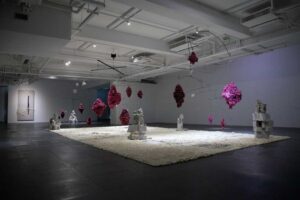by Ivy Leung in Hong Kong

Due to the ravages of Covid-19, the Art Basel Hong Kong 2020 held in Hong Kong every March was cancelled. The works of Hong Kong-based artist Andrew Luk (b.1988) and the post-war master Chu Teh-Chun (1920-2014), originally planned to be exhibited in Art Basel, are in the de Sarthe Gallery exhibition, Shifting Landscape.
Andrew Luk redeveloped his large hanging mobile installation Haunted, Salvaged in the de Sarthe Gallery. On the steel rods of the rotating device, disfigured orb-like objects of different sizes and uneven surfaces are hung. The orbs are constructed of layers of polystyrene, carved and corroded to compose an imaginary artificial constellation. Each orb resembles extensive catacombs that have been turned inside out. Our eyes trace the surfaces of the rounded outer contour of the orb-like objects while travelling through their cavernous interiors; inside are forms reminiscent of geological stalactites. These caverns reference the cliff face dwelling of our prehistoric ancestors from which we have modelled modern buildings. On the ground, underneath the swivelling orbs, is a desert-like 5m by 8m landscape of stainless steel mesh. Totem-like cement sculptures emerge in the landscape. The cracks between the cement blocks force out cactus-like tumorous blobs of dried expanding foam, creating a wasteland of disarray. Taking a closer look, each sculpture is built of concrete and antiquated electronic devices, such as Walkman and Gameboy.
The installation depicts a fictitious landscape which is full of anthropogenic contamination. It binds the natural and the man-made together. The artist realizes that the entities and forces that we create are as much part of nature as we are. Culture and technology have their own organic development with inherent needs, effects, and by-products. Contained in these entities is also the capacity for self-destruction. It is an inevitable stage in the cyclical progression of nature and evolution. As humans, we are both the participants and subjects of this process.
In the 21st century, complex petroleum-based materials have been used for human architecture. The materials are extracted from nature and refined through complicated processes. These materials are lightweight, cheap, and quick to manufacture, making them easily discardable and yet permanent fixtures on the earth’s surface. This represents a potential crisis for the destruction of the earth, but is merely understood as an environment undergoing inadvertent changes.
Human beings are a terraforming social species. They have been rapidly transformed by the culture and technology of previous generations. We must accept that this world is not inherited, but constantly being transformed. It is a world that has created immediate consequences. Humans should be like the fungi in the installation that have taken refuge. We must all learn from the environment and adapt ourselves in our own time. We have to embrace that reality is like a vaccination. It is a taste of an uncomfortable bile-like future.
At the other side of the gallery is a work titled Untitled by Chu Teh-Chun. He has created a painting with strong colours with a unique technique, freehand, known in Chinese as Hsieh yi. His broad, stretched, expressive brushstrokes elicit vast unexplored landscapes that are illustrated through a deeply rooted consideration of the traditions of Chinese painting and calligraphy. Nature unfurls within the canvas by distorting the viewer’s expectation of horizon and perceptive. His poetic expression of natural expanse uncovers realms of abstract form and proposes an alternative interpretation of medium and its capabilities. The vigorous power of the painting is impressive.
The two artists have very different perceptions of the natural world. No matter how nature will change, or how the terrain will shift, we should imitate the two artists, pay more attention and give more appreciation for Nature. And, at the same time, reflect more on human lifestyles.
由於新冠狀病毒肆虐,每年三月於香港舉行的香港巴塞爾藝術展2020 (Art Basel Hong Kong 2020) 因而取消。原本在是次展覧展出的駐港藝術家陸浩明 (生於1988年) 和戰後大師朱德群 (1920-2014) 的作品,移至德薩畫廊展出,名為《地勢轉移》 (Shifting Landscape) 。
陸浩明在德薩畫廊的空間重新裝置他的大型懸掛移動裝置作品《產物,殘物》(Haunted, Salvaged)。轉動的裝置鋼支上,掛著一個個大小不同、凹凸不平的球體,球體由一層層經雕刻腐蝕的聚苯乙烯組成,構造出藝術家想像中的人造星空。每一個球體彷似一個被翻轉內外的城市的地下墓穴,當視線找不到明顯的線索,我們會被迫逃進心理地理的環境中,在追踪球體外部輪廓的同時,亦會穿越其洞穴般的內部,從而令人聯想到面向懸崖有鐘乳石的洞穴,那是人類史前祖先的居所;人類以這些結構作為模範,建構出現代建築。懸掛的旋轉球體下的地面,是一片如沙漠般的5米乘8 米不銹鋼網地景,中間冒出一尊尊的水泥雕塑圖騰,水泥塊之間的夾縫逼出如腫瘤般的仙人掌狀膨脹泡沫,造成一片混亂的荒地。細看下,每尊雕塑都建構自混凝土和過時電子產品,如Walkman 和Gameboy。這些文明的殘餘物被埋在一片帶有未來色彩的過去與現在的荒地中。在水泥雕塑夾縫中出現的還有用聚氨酯造成的菌物,一株株新生命在這些紀念著過去加速科技時代的遺跡中得到庇護。
這裝置作品描繪著一個充滿人為汚染的虛構景觀,將自然和人造物融合一起。藝術家闡明了不只人類是大自然的一部分,由人類衍生的各類產物和動力也是大自然的一部分。例如文化和科技,一向被視為實踐人類思考的工具,但其發展過程卻如同其他生物一般,同樣有需求、同樣有發揮作用、也同樣造就出副產品、當中亦包含自我解體。這些存在特質,是自然進化的循環過程中的必經階段。作為人類,我們既參與這個過程,也同時被這個過程所牽引,彼此有著緊密不可分割的關係。
踏入21世紀,人類的建築增加了更為複雜的石油基材料。材料由大自然提取,經過複雜刁鑽的過程煉成。這些材料輕巧、便宜,又容易製造,它們方便丟棄,卻會永遠留在地球表面。這是地球毀滅的潛在危機,卻只被理解為一般的環境變化。
人類是一種地球化的社交生物,我們的腦袋經過幾千年以棍子和石頭進行狩獵和採集而不斷進化,被歷代的文化和科技加速改造。我們必須接受這個世界並非繼承的,而是不斷被改造的,那是一個每一刻都在產生即時後果的世界,人類應該好像裝置作品中那些得到歷史遺跡庇護的菌物一樣,從過去與現在的環境中學懂適應,並欣然接受,現實就如疫苗一樣,讓人嚐到那不舒服的、如膽液般噁心的未來……
畫廊的另一端,展出了法藉華裔藝術家朱德群的作品《無題》(Untitled)。他運用濃烈的色彩和獨特的技巧,創作寫意風景畫,粗獷舒展的筆觸反映藝術家自身對傳統中國繪畫和書法的思考和承傳。畫布上填滿大自然的力量,畫面扭曲著觀看者的視覺感知,對於廣濶自然的詩意描繪,朱德群另闢一種抽象的表現形式,對物料和技巧的運用提出新的演繹,為觀者帶來強而有力的視覺震撼。
兩位藝術家對自然世界有著截然不同的感悟。無論這個大自然將會如何轉變,又或者地勢將會如何轉移,我們都應該以兩位藝術家為楷模,給大自然多一點關注及多一點欣賞,與此同時,也要對人類的生活方式多一點反思。
Volume 34 no 6 July / August 2020
